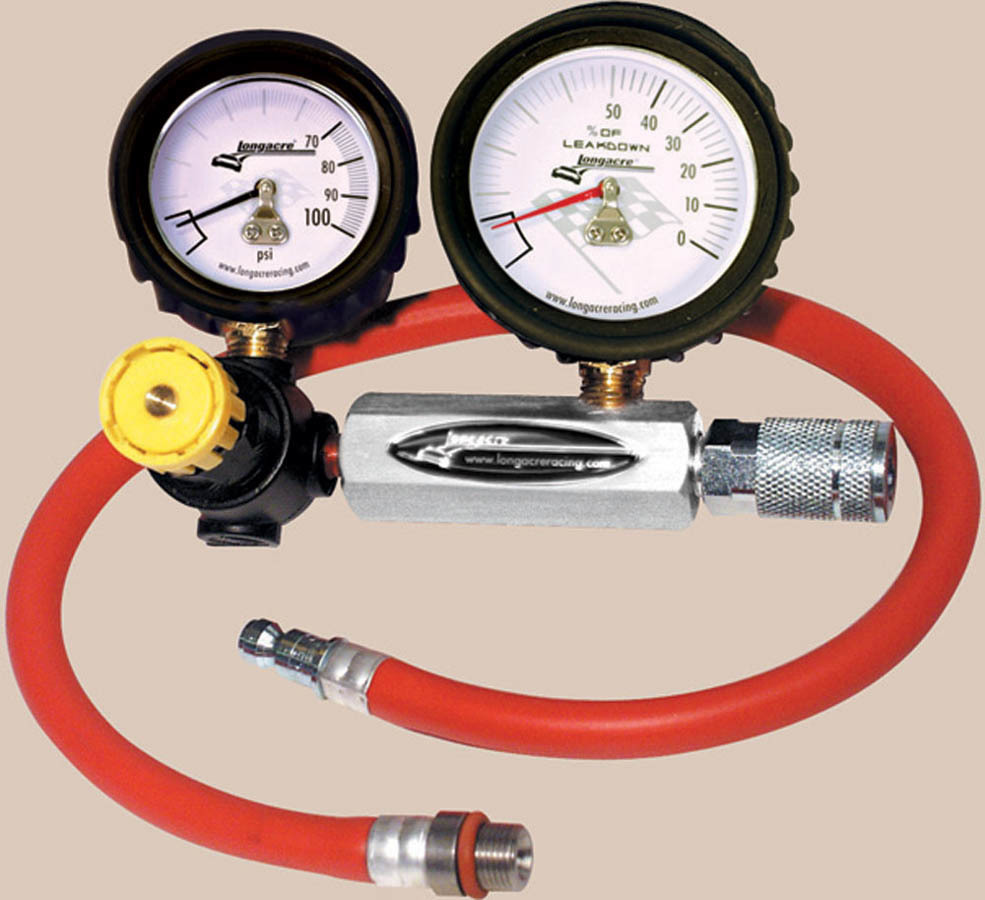Whether it’s used as a method of preventative maintenance or for troubleshooting, leakdown testing is an effective means of measuring the sealing efficiency of the piston rings, valves, and head gaskets. Whereas a compression test measures how much pressure is generated inside a given cylinder while cycling the starter, a leakdown test measures the amount of pressurized air that leaks out of a cylinder statically. Performed by engine builders and racers for decades, leakdown testing can not only be used to provide insight into an engine’s condition, but it can also be used to help pinpoint a potential problem, determining whether the engine, for example, may have a bent valve, broken piston ring, or blown head gasket.

Leakdown testers are relatively affordable and are available from a variety of manufacturers including Longacre Racing (LON73010), Proform (PFM66839,) and Total Seal Piston Rings (TOT14MMLDT). A typical unit consists of a manifold that is fitted with inlet and outlet pressure gauges, an air pressure regulator, and a whip hose with the necessary spark plug adapters. A balancer that is degreed in 90° increments or the installation of a timing tape will be required to perform the test. Available from Mr. Gasket for a variety of popular engines, a timing tape may be applied to the outer ring of the balancer so that engine may be rotated by hand in precise, 90° increments.
To perform leakdown testing, the engine should first be started and warmed to normal operating temperature. While performing the manual portions of the test, a pair of mechanic’s gloves such as those available from Allstar Performance are recommended to protect hands from hot engine components. After the engine has been shut down, proceed by removing the #1 spark plug and rotating the engine by hand using a 1/2” drive breaker bar until the cylinder is at TDC. This may be verified by removing the distributor cap and checking that the rotor is pointed at the #1 terminal.
Proceed by screwing the whip hose with the proper adapter into the spark plug hole and connecting it to the leakdown tester. Then connect the leakdown tester to a compressed air source capable of at least 100 PSI and adjusting the regulator so that the inlet gauge reads 100 PSI in order to simplify calculation of leakdown percentage. Finish by reading the outlet gauge to determine the amount of air that is leaking from the cylinder. For example. with the inlet pressure set at 100 PSI, if the outlet gauge reads 90 PSI, cylinder leakage would be 10%.
With the unit still connected, listen for air leakage at the crankcase breathers, air intake, and exhaust outlet. Air heard leaking from the breathers indicates leakage going past the piston rings. Leaks at the air intake indicate an intake valve that is not seating properly, while air coming from the exhaust or header outlet is evidence that an exhaust valve is leaking.
Next, slowly remove the radiator cap as to relieve coolant pressure and examine the coolant for bubbles, which would indicate the possibility of a head gasket leak. After the #1 cylinder has been checked and the results noted, replace the spark plug, remove the spark plug from the next cylinder per the engine’s firing order, rotate the engine 90° and check the next cylinder. The goal should be that leakdown percentages are relatively consistent from cylinder to cylinder. Proceed through the firing order, recording the results from each cylinder.
Once leakdown testing is completed, compare and review the results. Recording the results can come in handy when diagnosing a problem. For example. neighboring cylinders with high rates of leakage can signal the possibility of a head gasket that has blown between adjacent cylinders. Additionally, if a particular cylinder has a significantly greater amount of leakage than the others, it may be wise to run the engine again for a bit and re-check the cylinder in question in order to confirm the results. If a given cylinder offers the same results, it’s probably time to properly diagnose the problem before it gets worse.
Leakdown testing percentages should be consistent from cylinder to cylinder. When testing a variety of different engines, keep in mind that different piston ring packages will yield vastly different results. For example, an engine fitted with “Dykes” style rings that rely upon combustion forces for sealing may leak in excess of 20%, while traditional rings may result in roughly 8-12% and gapless rings may show as little as 1-3%. Because leakdown results are gained statically, these differences don’t necessarily mean that one engine is sealed up better than another. Only true “apples-to-apples” dyno testing can substantiate whether one ring package offers improved sealing efficiency and more horsepower over another.
There are many possible causes for a cylinder to leak out of the norm, including a broken or damaged piston ring, bent or pitted valve, blown head gasket, improperly adjusted valves, or simply top and second compression rings that have their end gaps lined up. Due to the simple fact that compression rings turn in the ring lands during engine operation, they will occasionally line up and create a virtual leak path. When encountering a possible dilemma, it’s best to check the basics before pulling the engine from the car, only to find out later that the problem was caused by something simple like valves that were out of adjustment or aligned piston ring gaps.
Although viewed as archaic by some, leakdown testing remains as an effective, quick, and inexpensive way to determine an engine’s condition and combustion sealing capability.